

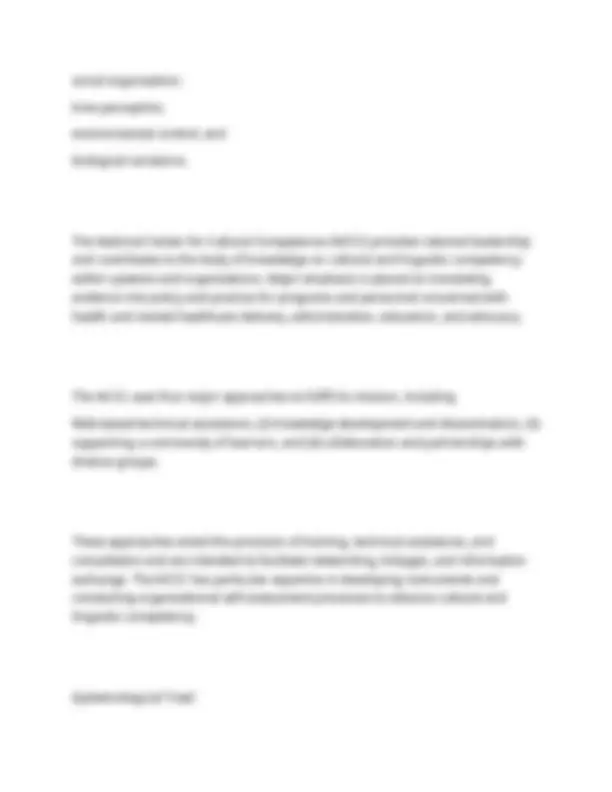

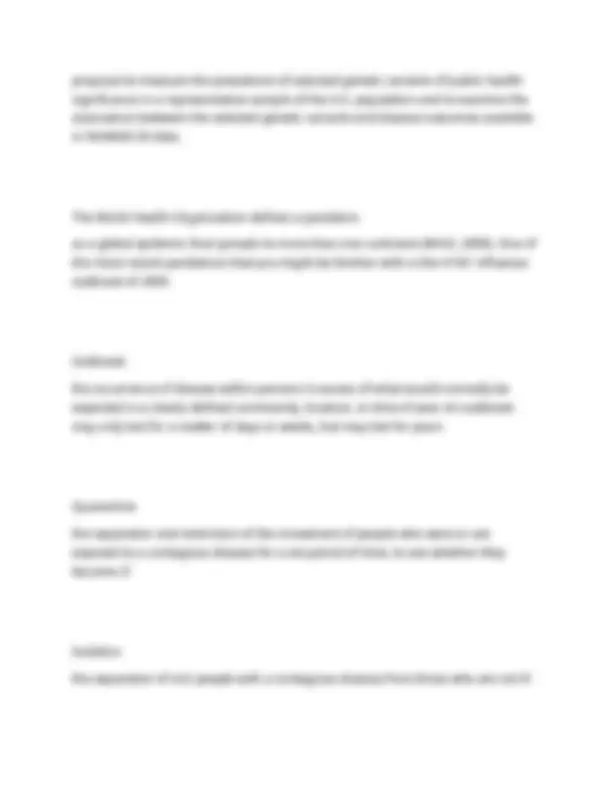
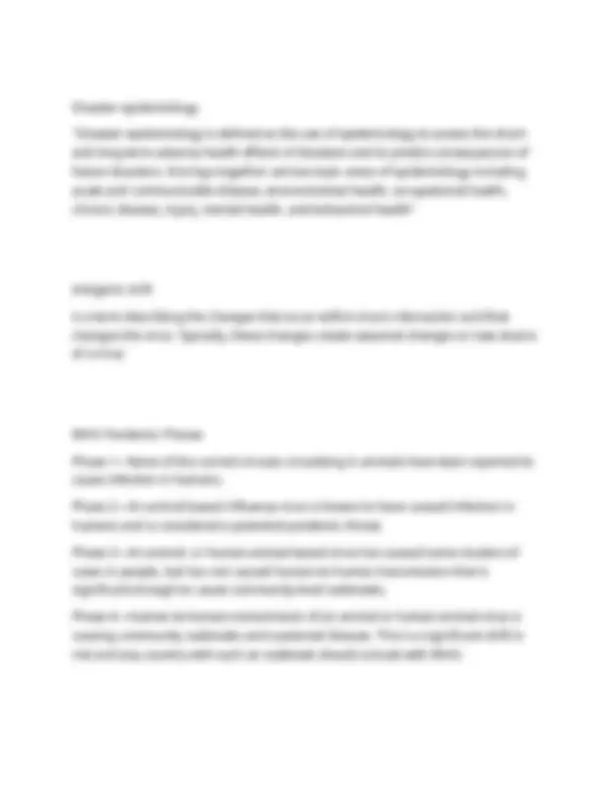
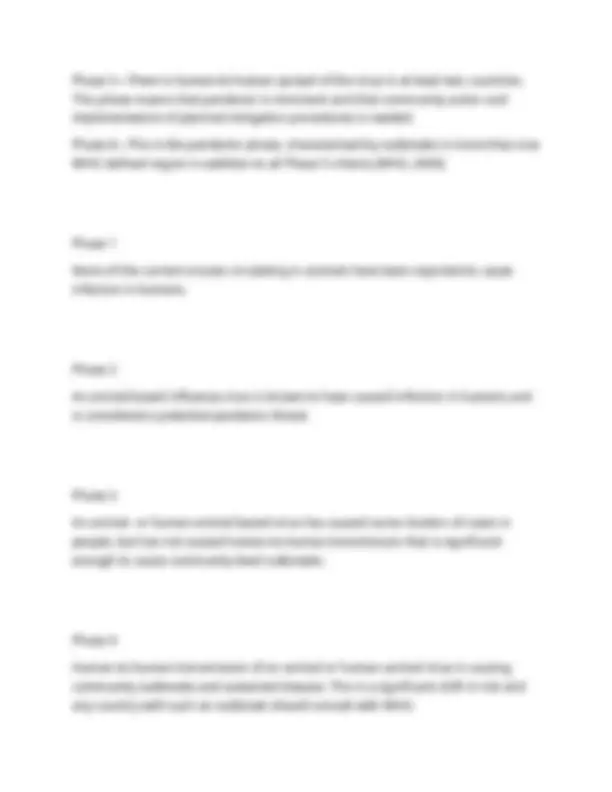
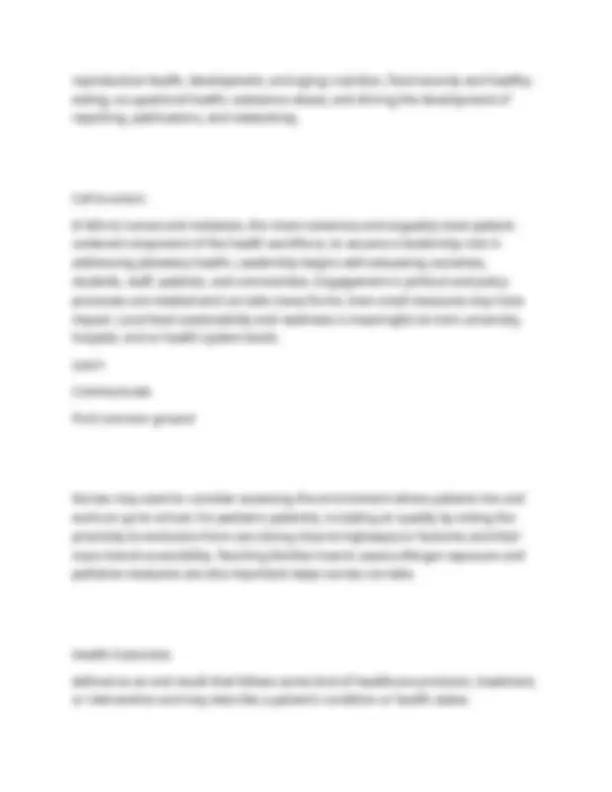
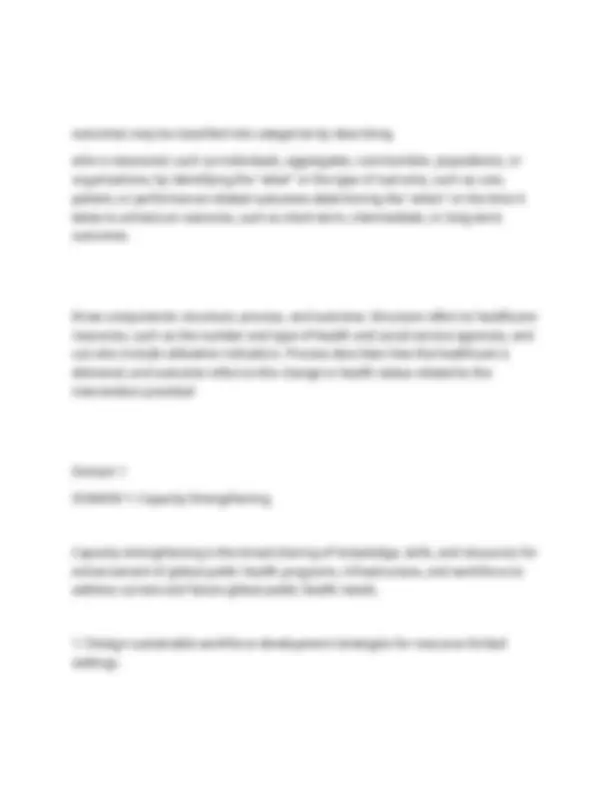
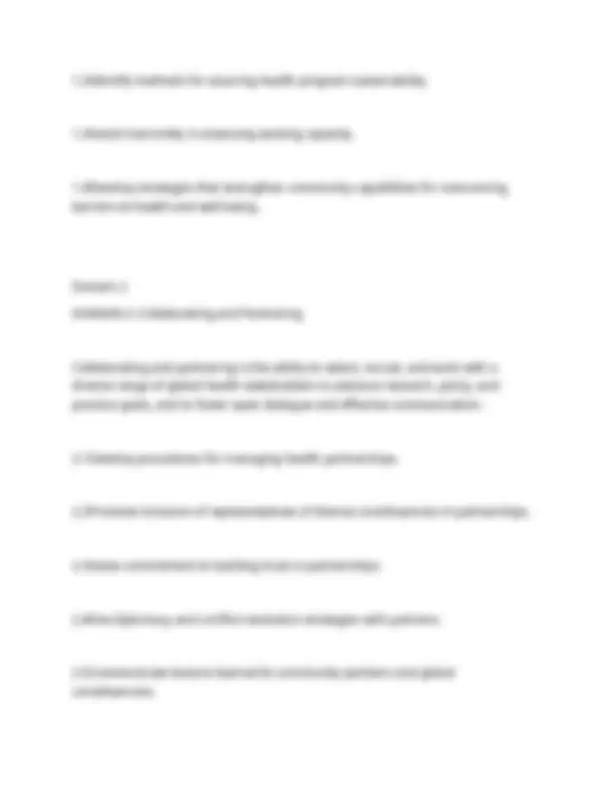
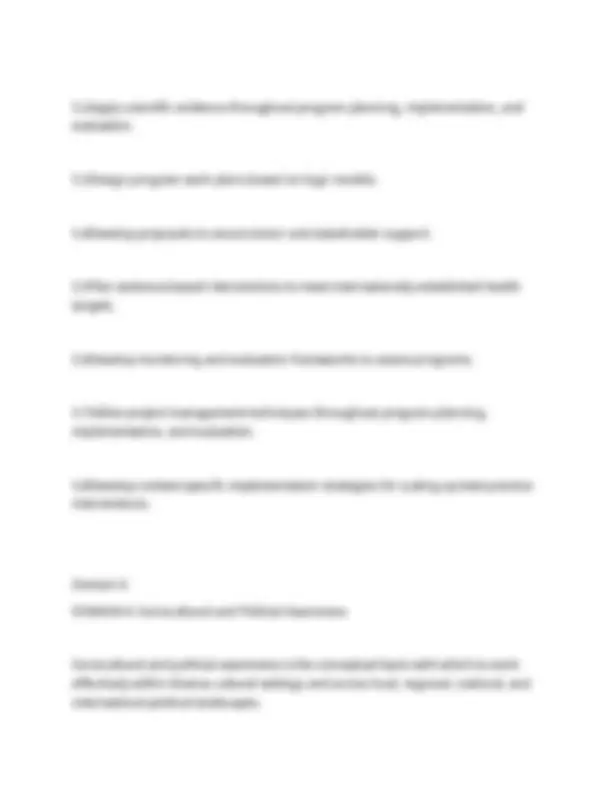
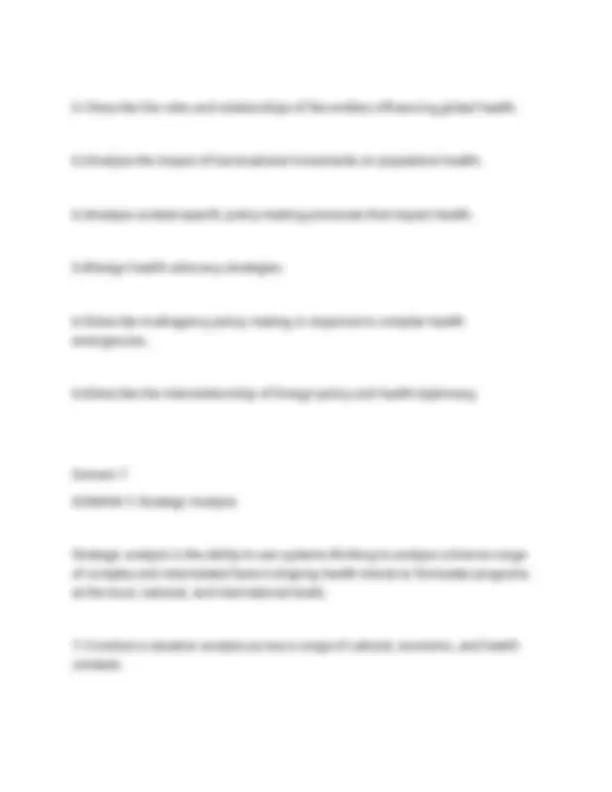
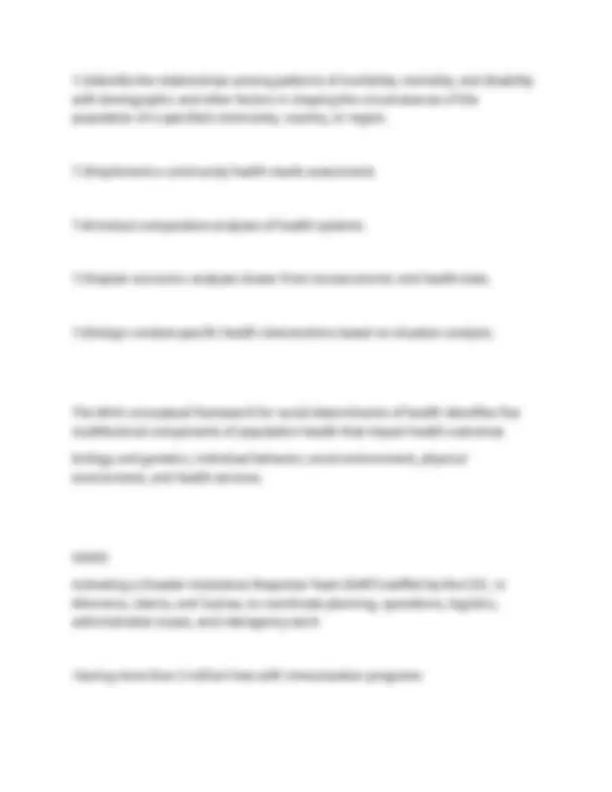
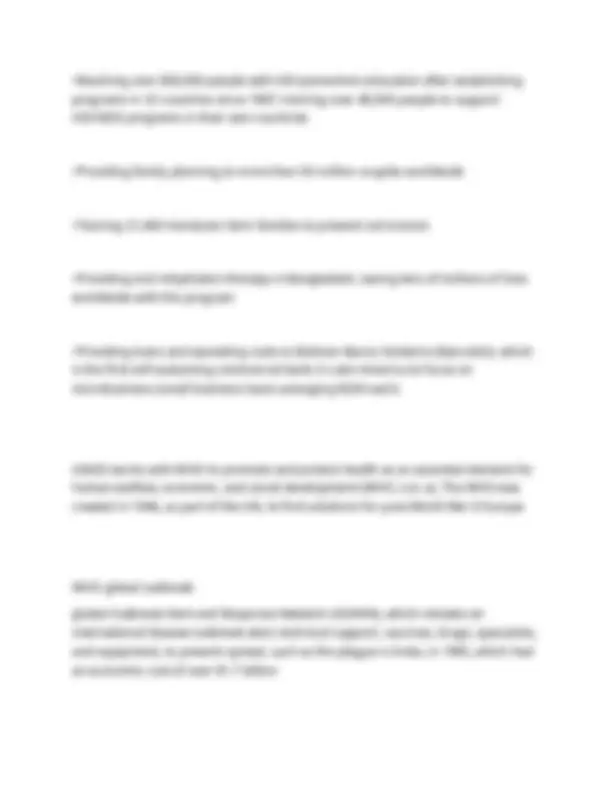
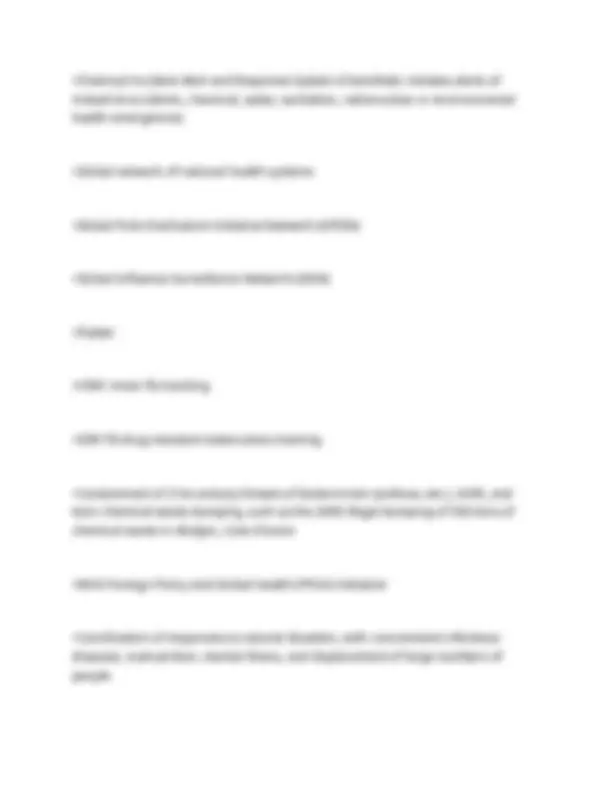







Study with the several resources on Docsity

Earn points by helping other students or get them with a premium plan


Prepare for your exams
Study with the several resources on Docsity

Earn points to download
Earn points by helping other students or get them with a premium plan
Community
Ask the community for help and clear up your study doubts
Discover the best universities in your country according to Docsity users
Free resources
Download our free guides on studying techniques, anxiety management strategies, and thesis advice from Docsity tutors
A concise study guide for epidemiology, focusing on key concepts such as the kleinman explanatory model, cultural competence, and the epidemiological triad. It covers essential definitions and frameworks used in epidemiology, including cultural awareness, humility, knowledge, skill, and desire. Additionally, it outlines the phases of a pandemic according to the who and discusses genetic epidemiology, risk assessment, and disaster epidemiology. This guide is valuable for students and professionals seeking a quick review of fundamental epidemiological principles and their application in public health. It also touches on the importance of cultural sensitivity in healthcare practices, making it a comprehensive resource for understanding and addressing health issues in diverse populations. The document also includes information on genetic epidemiology, risk assessment, and disaster epidemiology, providing a broad overview of the field.
Typology: Exams
1 / 27

This page cannot be seen from the preview
Don't miss anything!




















Kleinman explanatory Model Eliciting the patient's (explanatory) model gives the physician knowledge of the beliefs the patient holds about his illness, the personal and social meaning he attaches to his disorder, his expectations about what will happen to him and what the doctor will do, and his own therapeutic goals Cultural competence Cultural competence is defined as "a dynamic, fluid, continuous process whereby an individual, system or health care agency find meaningful and useful care delivery strategies based on knowledge of the cultural heritage, beliefs, attitudes, and behavior of those to whom they render care" Cultural Awareness :Self-examination of one's own prejudices and biases toward other cultures. An in- depth exploration of one's own cultural/ethnic background. Cultural humility A lifelong commitment to self-evaluation and self-critiques, redressing the power of imbalances in the patient- physician dynamic, developing mutually. Beneficial relationships.
Cultural Knowledge Obtaining a sound educational foundation concerning the various worldviews of differences cultures. Obtaining knowledge regarding biological variations, disease and health conditions and variation in drug metabolism. Cultural Skill: Ability to collect culturally relevant data regarding the client's health history and presenting problem. Ability to conduct culturally based physician assessments. Conducting these assessments in a culturally sensitive manner. Cultural Desire Motivation of the healthcare provider to "want" to engage in the process of cultural competence, characteristics of compassion, authenticity, humility, openness, availability, and flexibility, commi tment and passion to caring, regardless of conflict. ethnicity as "the aggregate of cultural practices, social influences, religious pursuits, and racial characteristics shaping the distinctive identity of community"
social organization; time perception; environmental control; and biological variations. The National Center for Cultural Competence (NCCC) provides national leadership and contributes to the body of knowledge on cultural and linguistic competency within systems and organizations. Major emphasis is placed on translating evidence into policy and practice for programs and personnel concerned with health and mental healthcare delivery, administration, education, and advocacy. The NCCC uses four major approaches to fulfill its mission, including Web-based technical assistance, (2) knowledge development and dissemination, (3) supporting a community of learners, and (4) collaboration and partnerships with diverse groups. These approaches entail the provision of training, technical assistance, and consultation and are intended to facilitate networking, linkages, and information exchange. The NCCC has particular expertise in developing instruments and conducting organizational self-assessment processes to advance cultural and linguistic competency. Epidemiological Triad:
host, agent, environment Genetics is considered an agent in the epidemiological triad Genetics The study of individual genes and their impact on relatively rare single gene disorders Genomics The study of all genes in the human genome as well as their interaction with other genes, the individual's environment, and the influence of cultural and psychosocial factors Genetic epidemiology the link of epidemiology and genetics Absolute risk is the probability of an event, such as illness, injury, or death
GAPPNet Genomic Applications in Practice and Prevention Network (established in 2009) is a collaborative initiative involving partners from across the public health sector working together to realize the promise of genomics in health care and disease prevention. GEDDI Genetics Early Disease Detection Intervention project (GEDDI) (established in 2009) developed a model strategy for using clinical, genetic, and family history information to reduce the risk of disease, death, and disability in affected individuals, family members, and populations. HuGENet Human Genome Epidemiology Network (HuGENet) (established in 1998) helps translate genetic research findings into opportunities for preventive medicines and public health by advancing the synthesis, interpretation, and dissemination of population-based data on human genetic variation in health and disease. HuGENet reviews are systematic, peer-reviewed synopses of the epidemiologic aspects of human genes, including prevalence of allelic variants in different populations, population-based information on disease risk, evidence for gene-environment interaction and quantitative data on genetic tests and services carried out according to specific guidelines. NHANES III DC's Office of Public Health Genomics (established in 2002) formed a multidisciplinary working group with members from across CDC. It developed a
proposal to measure the prevalence of selected genetic variants of public health significance in a representative sample of the U.S. population and to examine the association between the selected genetic variants and disease outcomes available in NHANES III data. The World Health Organization defines a pandemic as a global epidemic that spreads to more than one continent (WHO, 2009). One of the more recent pandemics that you might be familiar with is the H1N1 influenza outbreak of 2009. Outbreak the occurrence of disease within persons in excess of what would normally be expected in a clearly defined community, location, or time of year. An outbreak may only last for a matter of days or weeks, but may last for years Quarantine the separation and restriction of the movement of people who were or are exposed to a contagious disease for a set period of time, to see whether they become ill Isolation the separation of sick people with a contagious disease from those who are not ill
Phase 5—There is human-to-human spread of the virus in at least two countries. This phase means that pandemic is imminent and that community action and implementation of planned mitigation procedures is needed. Phase 6—This is the pandemic phase, characterized by outbreaks in more than one WHO defined region in addition to all Phase 5 criteria (WHO, 2009) Phase 1 None of the current viruses circulating in animals have been reported to cause infection in humans. Phase 2 An animal-based influenza virus is known to have caused infection in humans and is considered a potential pandemic threat. Phase 3 An animal- or human-animal-based virus has caused some clusters of cases in people, but has not caused human-to-human transmission that is significant enough to cause community-level outbreaks. Phase 4 Human-to-human transmission of an animal or human-animal virus is causing community outbreaks and sustained disease. This is a significant shift in risk and any country with such an outbreak should consult with WHO.
Phase 5 There is human-to-human spread of the virus in at least two countries. This phase means that pandemic is imminent and that community action and implementation of planned mitigation procedures is needed. Phase 6 This is the pandemic phase, characterized by outbreaks in more than one WHO defined region in addition to all Phase 5 criteria (WHO, 2009). Pandemic Severity Index Category 1—case fatality ratio of less than 0.1% and fewer than 90,000 U.S. deaths Category 2—0.1%-0.5% case fatality ratio and 90,000-450,000 U.S. deaths Category 3- 0.5%—1% case fatality ratio and 450,000-900,000 U.S. deaths Category 4—1-2% case fatality ratio and 900,000-1.8 million U.S. deaths Category 5—greater than 2% case fatality ratio and more than 1.8 million U.S. deaths (CDC, 2014). SDG's
reproductive health, development, and aging; nutrition, food security and healthy eating; occupational health; substance abuse; and driving the development of reporting, publications, and networking. Call to action It falls to nurses and midwives, the most numerous and arguably most patient- centered component of the health workforce, to assume a leadership role in addressing planetary health. Leadership begins with educating ourselves, students, staff, patients, and communities. Engagement in political and policy processes are needed-and can take many forms. Even small measures may have impact. Local level sustainability and readiness is meaningful at one's university, hospital, and or health system levels. Learn Communicate Find common ground Nurses may want to consider assessing the environment where patients live and work (or go to school, for pediatric patients), including air quality by noting the proximity to emissions from cars (living close to highways) or factories and their mass transit accessibility. Teaching families how to assess allergen exposure and palliative measures are also important steps nurses can take. Health Outcomes defined as an end result that follows some kind of healthcare provision, treatment, or intervention and may describe a patient's condition or health status
outcomes may be classified into categories by describing who is measured, such as individuals, aggregates, communities, populations, or organizations; by identifying the "what" or the type of outcome, such as care, patient, or performance-related outcomes determining the "when" or the time it takes to achieve an outcome, such as short-term, intermediate, or long-term outcomes three components: structure, process, and outcome. Structure refers to healthcare resources, such as the number and type of health and social service agencies, and can also include utilization indicators. Process describes how the healthcare is delivered, and outcome refers to the change in health status related to the intervention provided Domain 1 DOMAIN 1: Capacity Strengthening Capacity strengthening is the broad sharing of knowledge, skills, and resources for enhancement of global public health programs, infrastructure, and workforce to address current and future global public health needs. 1.1Design sustainable workforce development strategies for resource-limited settings.
2.6Exhibit interpersonal communication skills that demonstrate respect for other perspectives and cultures. Domain 3 DOMAIN 3: Ethical Reasoning and Professional Practice Ethical reasoning and professional practice is the ability to identify and respond with integrity to ethical issues in diverse economic, political, and cultural contexts, and promote accountability for the impact of policy decisions on public health practice at local, national, and international levels. 3.1Apply the fundamental principles of international standards for the protection of human subjects in diverse cultural settings. 3.2Analyze ethical and professional issues that arise in responding to public health emergencies. 3.3Explain the mechanisms used to hold international organizations accountable for public health practice standards. 3.4Promote integrity in professional practice. Domain 4
DOMAIN 4: Health Equity and Social Justice Health equity and social justice is the framework for the analysis of strategies to address health disparities across socially, demographically, or geographically defined populations. 4.1Apply social justice and human rights principles in public health policies and programs. 4.2Implement strategies to engage marginalized and vulnerable populations in making decisions that affect their health and well-being. 4.3Critique policies with respect to impact on health equity and social justice. 4.4Analyze distribution of resources to meet the health needs of marginalized and vulnerable groups. Domain 5 DOMAIN 5: Program Management Program management is the ability to design, implement, and evaluate global health programs to maximize contributions to effective policy, enhanced practice, and improved and sustainable health outcomes. 5.1Conduct formative research.
6.1Describe the roles and relationships of the entities influencing global health. 6.2Analyze the impact of transnational movements on population health. 6.3Analyze context-specific policy-making processes that impact health. 6.4Design health advocacy strategies. 6.5Describe multiagency policy making in response to complex health emergencies. 6.6Describe the interrelationship of foreign policy and health diplomacy. Domain 7 DOMAIN 7: Strategic Analysis Strategic analysis is the ability to use systems thinking to analyze a diverse range of complex and interrelated factors shaping health trends to formulate programs at the local, national, and international levels. 7.1Conduct a situation analysis across a range of cultural, economic, and health contexts.
7.2Identify the relationships among patterns of morbidity, mortality, and disability with demographic and other factors in shaping the circumstances of the population of a specified community, country, or region. 7.3Implement a community health needs assessment. 7.4Conduct comparative analyses of health systems. 7.5Explain economic analyses drawn from socioeconomic and health data. 7.6Design context-specific health interventions based on situation analysis. The WHO conceptual framework for social determinants of health identifies five multifactorial components of population health that impact health outcomes biology and genetics, individual behavior, social environment, physical environment, and health services. USAID Activating a Disaster Assistance Response Team (DART) staffed by the CDC, in Monrovia, Liberia, and Guinea, to coordinate planning, operations, logistics, administrative issues, and interagency work •Saving more than 3 million lives with immunization programs